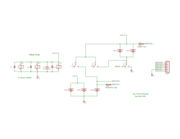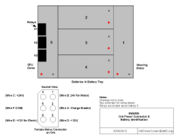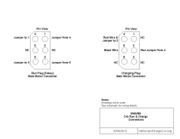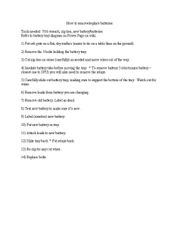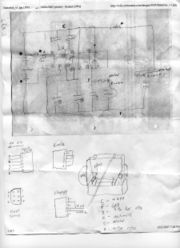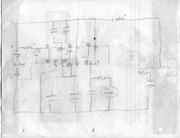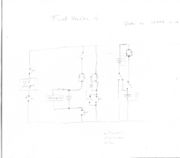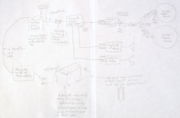Power
Contents |
How to Test our SLA Batteries
- Test voltage. It should be above 12 volts or so. If not, put in the “maybe dead pile”
- Put 3 100 ohm resistors in parallel. (they are in the cabinet in the container) Put them across the battery with test leads with alligator clips
- Test voltage. If it’s below 8 volts, put in the maybe dead pile
- Repeat for all batteries
Test the Maybe-Deads
- Charge the batteries in the maybe dead pile.
- If they fail a second time, discard.
Rechargeable AA Batteries for the Remote Controls
In the container you'll see a AA battery charger sitting on the battery shelf. Feel free to use the batteries in there for the orb remotes. When it's left plugged in, it trickle-charges at 10mA... so it'll give a full charge in about a week... or you can leave the AA batteries on the charger all the time. Or if you unplug the charger and plug it back in, it will go through a 200mA, 5 hour charge cycle, charging them in a day.
I have experienced an orb remote battery failure when I was in Scottsdale. Here's what happens: the orb stops responding to the controls... lights don't change, sounds don't play, no movement. If that happens to you, swap out the orb remote batteries!
- Each remote control gets 2 AA NiMH batteries.
- Yes, the "battery low" light will start blinking within 5 minutes, that's ok.
- You'll know the batteries are flat when the orb you are controlling starts not listening to your commands all the time. Experience shows that it takes 2-12 hours for batteries to wear out (it's probably more like 6 hours but we haven't tested it accurately)
- Bring along a spare set of batteries in one of the clear 4 AA battery holders. The battery holder has a little slip of paper on it that reads "Full Batteries" and "Empty Batteries".
- Once the batteries are dead, swap them with the batteries in your spare battery holder and flip the paper to "Empty Batteries"
- Back at the shop, if you see a set of dead batteries and you have the time, put them in the charger.
How to use the Vanson AA charger:
- put in the batteries
- set it to "Nicad"
- unplug and re-plug the charger to reset the timer. Note the lights turn on
- leave it for 5 hours and it will put 1,000 mah into the batteries
- It's ok to leave the batteries in the charger indefinitely. It charges them at 10mah after 5 hours.
Notes: if you set it to NiMH, it will charge at 200mah for 10 hours, which is a bit long for these gently used 1700 mah batteries. If you touch any batteries and notice they are really hot (160 degrees or so), take them out, they are done charging and just burning themselves up
Orb Power System Components
Refer to diagrams in the right column below the TOC for more information; you can hide the TOC if it gets in the way!
- 5 7 Ah 12 volt used UPS batteries from Mr Luka.These batteries are currently,Yuasa "NP7-12" sealed lead acid batteries http://www.yuasabatteries.com/pdfs/MSDS_LeadAcidBattery.pdf
- 3 ProLink SPDT40M 40 amp @ 12 volt relays (from [www.halted.com HSC Eleectronics])
- 3 IN4004 diodes; one on each relay
- 1 470uf/50v electrolytic capacitor; on relay K3
- A mess of spade quick disconnects
- About 10' of 14 gauge wire
- A pair of 4 pin molex connectors for the kill switch
- 1 female and 2 male 6 pin molex connectors for the battery charging system.
- 1 fuse block from Kragen (part #156000620)(Bussmann Fuse Accessory)
- 10 (electronics) and 25 (motors) amp ATC fuses
- 2 in-line ATC fuse holders for the motors
- Labels for all those battery wires http://www.grainger.com/Grainger/items/3TP21
- Schumacher Speed Charger — 10/6/2 Amp, Model# SC-1000A (always set to 6 amp, AGM/Gell cell)
Battery Replacement
- Refer to the instructions that appear in the right column below the TOC
The Orb Charging System
Features:
- The system allows us to charge a dual voltage battery system (12 volts for electronics, 24 volts for motors) with just a single, 12 volt charger.
- It makes sure not to cause any voltage spikes for the 12 volt system when the system is being plugged in or unplugged.
- It has no switches that might be mistakenly flipped while in the hot sun of Black Rock City (or San Francisco) making it (knock on wood) foolproof.
- A fail-safe kill switch allows us to remove power from the motors by pulling an easily reached plug
- A "fakey" molex plug ensures that no power goes to the system unless it is plugged in.
Disadvantages:
- If the lone 12 volt battery is in a dramatically different discharge state from the other 4 batteries, when the charging system is plugged in, a tremendous current surge from one system to the other might cause damage or battery wear
- If the battery charger is plugged in but not powered, the batteries will run down while powering the charging relays. Lee tried to find a fix for this with diodes but it turns out to require a larger redesign to fix this.
- The orb's electronics system cannot be running while it's being charged.
Considerations for Next Version of Power System
Here is a circuit to limit inrush current.
Jon suggests:
At the cost of separate 24V and 12V chargers, we could connect the battery pack to the chassis with a three-pin connector (12, 24, and GND) that could also serve as the charging connector. Advantages: * Makes it easier to swap out battery packs as designed. * Eliminates most of the confusing wiring tangle, simplifies troubleshooting, and makes it easy to fuse. * Makes it safe to leave Orbs on the charger (OK, charger*s*) indefinitely. I saw a 1.5 amp 24V charger at surpluscenter for nine bucks. On two sets of batteries in series, that's actually more oomph (.75A) than charging 5 batteries in parallel on the 2A setting (.4A). http://www.surpluscenter.com/item.asp?item=11-3150
Or... switch to an entirely 12 volt system. We have to see if the drive system likes getting 12 volts.
Michael writes about a 12 volt system...
I don't know whether we'd have problems with isolation, but I think Jon did a good job with the h-bridges and the DC-DC converter should be pretty good; I've been less careful and still gotten good results (all though you always have to worry about the ADC accuracy.) Right now the turbo mode is way too slow; I think the voltage needs to increase by at least 50%, if not 100%. In grassy environments, we get stuck all the time, and we don't have the speed we need to cover the distances dictated by the uncertainty of our measurements. If turbo mode is currently less than 25% duty cycle, than we can probably get enough speed and still go to 12V. If turbo mode is more than 40%, then we probably need the 24VDC for some environments.
Power Requirements
For the Mothership
- At Burning Man 2007, we used Cory's "Playa Proof 'Pooter". It drew about 30 watts. We hooked up 4 7ah batteries up in parallel into an inverter and it ran for 2-6 hours each night. One night, it ran out of juice after just 2 hrs... we don't know why.
- 4 cold cathode lights powered by a single 7ah battery. Each draws about 0.1 amp. They pretty much ran all night.
For the Hive
- The Laser Tower at Burning Man 2007 had a 5 watt luxeon and 60mw laser. On 1 7ah battery, it ran from about 7pm to 11am.
- We had about 200 ft of EL wire on the hive. It ran all night... (not as long as the laser tower but all night) on 2 7 ah batteries.
For an orb
- 1 7ah battery for the electronics (sound, SPU computer, Zigbee) ran at least 4 hours in intermittent use :-)
- 4 7ah batteries for the motors (drive, steering) ran at least 4 hours in intermittent use :-)
BM 2007 Charging System
See Power section on Private wiki (There's some phone numbers and names that aren't public)
At Burning Man 2007, we used 10 125 solar panels from Barry Cogbill, 300 amp/hrs of rented batteries and an inverter from Sno Koan. We were planning on running 2 shows a day, using 5 kilowatt-hrs per day. We sometimes ran just 1 show. Battery life for the solar system was not a problem at all :-)
Barry has 42 "Kyocera 125" panels, delivering 100 watts each. Dimensions 56.1" x 25.7" x 1.42". 26.9 lbs each. We can borrow up to 20.
Here's more good solar info.
Battery Options
Where to get our batteries
In June 2007 Peter Luka sold us about 50 7ah batteries, mostly Yuasa NP7-12 at $4/each (retail $15) batteries
Alameda County Computer Resource Center - Lee ripped a pile of batteries out of UPS units in early 2008 but they -all- turned out to be dead (they tested at 12v+ at ACCRC but none would hold a charge). Another try might work, it all depends on what's passing through the facility that month. James, the owner is all about crazy alternative energy robot projects etc... At Maker Faire 2007, James told Lee, "Show up with a truck and take as many of these (7ah 12v) UPS batteries as you want. And when you've killed them, bring them back to me and I'll get rid of them." Hmm, nice offer!
Yuasa NP7-12
Total cost for 6 orbs and charging:
total cost $4 * 5 (per orb) * 6 orbs = $120
standard charger $120 * 2 chargers (maybe fewer chargers) = $240. Or we can get away with current limited power supplies... total about $100 but we have to watch them carefully
$360 total
The batteries we have now. $4 each 7amp*hr 12 volts.
4 for drive and steering. 1 for electronics.
Tested strength:
1 12v battery
at 5:04pm 12.92v
at 5:11pm 10.8v
drawing 155 watts of incandescent lights from an inverter. That's 12 amps
1 battery lasts 7 minutes at 155 watts
Odyssey Batteries turned out to be too expensive and the Yuasa SLAs work just peachy keen. Would have been nice b/c can be charged quickly at 50 amps. 12v, 25 amp charger for odyssy bc-omax $143, charger specially designed for Odyssey. A friend told Lee that Odyssy batteries don't need to be charged on the special (expensive) Odyssy charger.
NiMH Batteries - Nope. We want the higher density. Building a 24 volt 10 amp hr battery from this: .35 lbs apiece * 20 pieces = 7 lbs $6.50 each * 20 = $130
Charging Options
We charged off a Honda EU3000 at Coachella 2008 no problem. 6 orbs charging at 6 amps for 4 hours.
Pedal Powered Generator - plans for a bicycle powered generator. 1 person can generate about 100 watts for 30 minutes. That's a -lot- of pedalling :-(
Honda EU2000i weighs 46 lbs. 1600 watts continuous. $900. Anyone want to go halves-ies on buying a generator?
The Honda EU3000is weighs 140lbs so it's hard to put on the Mothership. It can be bought for $1,500 or rented for $300 + $40 in gas for the week.
Burning Man gas usage math for EU3000is 3.4 gallon tank 2.8 kilowatt rated will run 7 hrs at rated capacity on one tank of gas 2.8kw * 7 hrs = 19.6 kilowatts per tank of gas We need 2kilowatts for 4 hrs a day for 7 days 2 * 4 * 7 = 56 kilowatt hrs total 56 kw / 19.6 kw per tank = 2.9 tanks 2.9 tanks * 3.4 gallons per tank = 9.9 gallons 9.9 gallons * $3.50 / gallon = $35 $35 in gas for the honda
Direct solar charging
Direct solar charging from 1 panel to 1 battery set is impractical because
- we would need a solar charge controller for each orb (expensive) (each orb gets an $80 Sunsaver 10-12-LVD. It's a 10 amp charge charger. Hook 1 solar panel up to each orb. total cost $80 * 6 = $560 in chargers)
- we could only charge during the day
Interestingly, each panel generates 7 amps and 15 volts = 100 watts. So we'd hook each panel up to 1 orb for about 4 hours.
Ganged charging would look like this:
35ah * 6 = 210 ah total
Morningstar 60 amp controller $200. Hook all 6 orbs up to 6 panels.
total cost $200 in chargers
Battery Hints from Steve Nelson
Power your drive-train motors separately from you Logic Circuits and keep the grounds common and you will be OK. Never( brown out) your Logic with the same source as your drive motors or the major load of your machine. Feed your Logic controls separate of the drive load for best results. That's standard robotics from the real world and Trial and Terror. Common ground, Separate power works best. If I wanted to beat you in combat I would tell you the opposite. Basically trust in Team K.I.S.S .. Separate sources is the way to go...
Keep the logic control and motor drive loads on separate battery sources for best results with common grounds for proper control signal strength. This is the way to do system and load control if you really want your machine to work. I'm only a electronic Tech.. But I'd never lie to or challenge an Engineer. Because they wouldn't listen and I would have to fix what they built. Team K.I.S.S theory.... Separate Control Circuits From motor loads and LOGIC circuits for best results. Of course keep the grounds common for signal and drive. Gear down your electric motor to at least half of their stall torque rating and current draw for best results. I want you folks to do it right. Even if your engineers and stuff. The real bitch of REAL robotics is trying to do with less than you really need. after that you really need to ponder gear reduction's. There isn't Any Math that can solve the TORQUE/WEIGHT problem other than the simple math. Weight times the Arm and stuff
Ya the darn battery dilemma. I know you can't afford Lipoly or Li-Ion and that technology is still a bit iffy and possibly dangerous. The best common batteries for performance are Ni-Cads but the cost is prohibitive with the budget you have to work with. They can produce about 90% of their amp hour rating under load. But the problem with them is you have to use several packs in parallel to get the high current draws from them. Of course they can be fast charged with the proper charger. But if you want to do a bit of drooling over high performance battery packs. You can look at some well built Ni-Cad packs here... http://www.battlepack.com/
Generic Sealed lead acid types of course are cheaper.
http://www.batterymart.com/c-04-12-volt-sealed-lead-acid-batteries.html
PowerSonic Batteries (slightly better than all the other standard SLA's) (They must still be slow charged)
http://sacramentoelectronics.com/ps/12volt.html
Hawker Odyssey AGM SLA's. These are as good as SLA batteries get (also they can be fast charged similar to an automotive wet cell battery) You can actually charge them with an automotive charger. These are the only SLA's you can do that to. They are a totally different critter than standard SLA's. These puppys will flow tons of current (of course their run time is still about the same) But their perfomance under load is awesome because of their LOW internal resistence. I use these in my combat robots because of the instant power they provide under severe loads. http://www.batterymart.com/c-odyssey-batteries.html
Two of these 16 amp hour batteries might just provide the 24 VDC for you drive motor if you can keep you current draw low with proper gearing and you can fast charge them.
http://www.batterymart.com/p-odyssey-pc625-battery.html
or these
http://www.batterymart.com/p-odyssey-pc680-battery.html
Of course they cost more than regular SLA's. But you get what you pay for. Battery Mart has pretty good prices for some SLA's But it never hurts to shop around and don't forget to consider the shipping cost's. That darn Lead is pretty heavy stuff....
Other stuff
Mark recommends http://focus.ti.com/lit/ds/symlink/pt4244.pdf 10 watt 24v DC-DC converter
Pete writes
- The ETek GPS wants 3.3-5 volt supply.
- The Speed Controller (AVR) can use 3.3 volts if the speed is kept to 10mhz, or 5 volts for 20mhz
- The current sense Op-Amps, as spec'd use +5volts, but I suppose these could be re-designed to use 3.3volts.
The Linux board says it wants a regulated +5volt input supply.
The HBridge boards take raw 24v battery, and have an onboard 12v switching regulator to supply it's components.
It looks like we have a number of components that need somewhere to live, and power supplies.
I suggest a PC board that has both 5 volt and 3.3 volt regulators on it, holds the Xbee and IMU modules, the AVR for speed control, the Current sense OpAmp circuits, and supplies power to the GPS and Linux board.
(Not needed) Tad has 2 Interstate UL16 375ah 6v batteries for $250 each. compare them to other Interstate batteries: http://www.interstatebatteries.com/www_2001/content/products/product_6volt.asp
General Battery Information
The Desulphator Experiment * Plugged in the FLG deep cycle battery to desulphate on 5-28-08. Sitting voltage was 12.9. After 15 minutes on the fancy charger, it seemed to be at full charge. Lee will leave it on desulphate for a long time and we'll see... * 6-4-08 FLG sitting voltage was 13.08. Hmm, the desulphator might actually work :-). from http://www.battery-service.de/daten/bleiakku.pdf constant voltage charge: 0.4 C at 2.4-2.48V per cell. Takes 6-12 hours. Current starts to fall off after 2 hrs or so. "constant-voltage charging is recommended" p16 recommended cut-off voltage under different loads: 0.1A --10.6V 1.0A -- 9.8V 2.0A -- 9.0V when drawing power at 1C, capacity is 60% of rated p16 when drawing power at 0.25C, capacity is 80% of rated when drawing power at 0.05C, capacity is 100% of rated cycle life vs depth of discharge: (you'll get this many charges if you discharge it this many times) 100% -- 200 charges 50% -- 500 charges 30% -- 1200 charges V-Taper battery charger will charge the battery in 90 minutes and give twice as many charges as with a constant voltage charge in 6 hours. trickle/float charge should be set to 2.3V per cell -------------------------------------------------- Everstart cosel vector (bad brand?) TrippLite MAAS SPS9400 40 Amp radio Shack regulated supply computer power supply.... ok voltage for charging??? MPJA 12V 12.5 Amp Astron RM60A 13.8 Volt 60 Amp linear power supplies lots more here: http://www.rcgroups.com/forums/showthread.php?t=197410&page=4 and here http://www.rcgroups.com/batteries-and-chargers-129/ Die Hard 30 amp charger $70 = DieHard Microprocessor - Controlled Battery Charger and Tester, 80 Amp Engine Start Sears item #02871225000 Mfr. model #71225
Links
- http://www.uuhome.de/william.darden//batlinks.htm
- http://uuhome.de/william.darden/
- http://www.eflightpacks.com/
- http://www.thomas-distributing.com/index.htm
- http://www.batteryspace.com/index.asp?PageAction=VIEWCATS&Category=286
- http://www.srbatteries.com/
- http://www.cheapbatterypacks.com/main.asp?sid=754995&
- http://www.batterymart.com/
- http://www.dynamoelectrics.com/
- http://www.rcbatteryclinic.com/
- http://xtronics.com/reference/batterap.htm
- Barry recommends http://solardepot.com/, they are in Santa Rosa. Lee spoke with Milton at 707-766-7727 ext113
